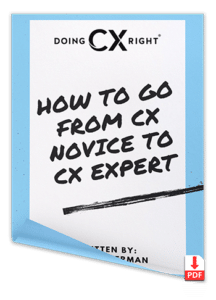
by Stacy Sherman | Aug 8, 2022 | Featured Blog, Personas & Journey Mapping
Customer satisfaction and NPS are useful measurements of business success, just as much as revenue and profitability. (And, now there’s NPS 3.0, as the creator Fred Reichert explains on my podcast). While there are many ways to gather customer insights, how does a company increase the chances that customers will rate their interactions highly and remain brand loyal? The answer is by creating customer experiences leveraging the power of journey mapping. If you are unfamiliar with this important CX practice, read my other article: WHAT Is A Journey Map and WHY Create One?
As a refresher, the purpose of creating a customer journey map is to help design better products and services and overall great experiences. It is a valuable method to identify problems and areas of success as customers become aware, learn, buy, get, use, etc. While Journey Maps typically look visually different from one organization to another, they consistently enable you to empathize with how customers feel when interacting with a brand.
CMS wire recently published an article by Jennifer Torres about strategic approaches to journey mapping. Below is a summary with contributors including CX expert Jeanne Bliss and me.
The original article can be found
here.
What’s in your abandoned cart?
From a tube of mascara to a jade bracelet or water pump, retailers are paying the price for the items left behind. And the price tag? $260 billion in lost revenue over 10 years (in the US and EU) due to preventable cart abandonment, according to the Baymard Institute.
The Importance of Customer Journey Mapping
As CEO of MaxxoMedia, a boutique digital customer experience consultancy, Levy previously served as Vice President of Digital Experience at Comcast and recently debuted a newsletter focused on the digital customer experience.
“Journey mapping can help provide insights into every part of a customer’s experience,” said Levy, “and to evaluate why a particular part of the journey isn’t working, the investigation needs to go deeper into the micro-steps.” When it comes to abandoned carts, Levy explained, journey maps, combined with web and journey analytics tools, can expose friction and assist in optimization.
Data from the Baymard Institute revealed that, on average, nearly 70% of online carts are abandoned. And while some customers are just browsing, research revealed more than 40% of shoppers discard their cart for “fixable” reasons, like:
- Extra costs for shipping, tax, and other fees
- Security concerns about sharing credit card information
- A long or complicated check-out process
- Website errors
- Being required to create an account
Anytime you define new — or optimize existing — customer experiences, Levy says you should take the time to build a journey map. “A journey map is a tool that helps you understand the entire customer journey and identify areas for improvement.”
“This,” he continued, “becomes the blueprint for your experience and creates a common view and language for the business to identify opportunities and moments of friction. It’s a powerful way to define your strategy, align everyone around the same goals and create an actionable plan for improvement.”
6 Steps for Creating a Customer Journey Map
Levy’s strategy for journey map creation includes several steps.
1. Start With a General Map
One that accounts for the major journey moments or “moments of truth” (MOTs) — regardless of the type of customer. MOTs are the intersections where customers have an opportunity to evaluate their experiences and decide about their relationship with your brand.
2. Map Major Journey Moments
How does the customer learn about, then purchase, receive, activate/set up and enjoy the product or service?
3. Overlay Customer Expectations and Outcomes
Identify what the customer learns, does, and feels in each moment. For example, after making a purchase, they may feel excited about receiving an item in the mail or disappointed if there’s an issue with their order.
4. Create Sub-Journeys
Once you know what the major moments are, it’s time to break them down into smaller steps so that you can see how they work together as part of an overall experience. For example, after a purchase, send an email confirmation and direct the customer to download the app to get ready for activation.
5. Identify Channel-Specific Support Moments
Identify and overlay key moments by channel — web, app, social media, email, SMS, etc. For example, manage expectations about delivery by sending an SMS that links to a real-time tracking webpage.
6. Think About Personas
Personas are an overlay to the master journey map. Usually generated by the marketing department, personas paint a picture of audience segments through quantitative and qualitative research. Examine the map again based on details from these target market personas to determine if journey changes need to be made.
According to Levy, when it comes to supporting journey mapping, nothing is better than talking directly with customers to get firsthand insights. “To add further color and detail to the journey map,” Levy continued, “gather and synthesize data through surveys and ethnographic studies, third-party research as well as existing company journey analytics — escalations, text analytics from chats, calls, social media posts and forums.”
How to Keep Emotion in Customer Journey Mapping
Stacy Sherman, VP of Marketing, Agent & Customer Experience for Liveops, and founder and host of the DoingCXRight podcast and blog, said one of the main goals of a customer journey map is to better understand how customers feel when interacting with a brand.
“You want to put yourself in the ‘customer shoes’ and identify the emotions they feel along the journey,” Sherman said. You can do this, she said, in three steps:
1. Define Personas
The first step is to get an accurate understanding of who the target audience is. You’ll want to ask questions about age, income, and education. But equally important is discovering the needs and obstacles your audience faces and where they go to find information that informs their decisions.
2. Identify Touchpoints
Touchpoints are the moments a customer engages with a brand. They can include advertising, social media posts, a website, online search results, and much more. According to Sherman, it’s important to find out what emotions customers feel at various points along the journey.
For retailers with both online and brick-and-mortar stores, they must consider digital and “on-site” touchpoints, such as in-store signage that promotes social media pages, text opt-ins or newsletter signups.
3. Dig Up Data
Once you’ve completed steps one and two, it’s time to start digging into your customer data. You should incorporate quantitative and qualitative insights from both internal and external sources.
You’ll also want to stay on top of ongoing data trends — like web browsers doing away with third-party cookies — to better understand what type of data you should collect and what to do with it.
Applying Neuroscience to Journey Mapping
Ed Powers is principal consultant for Service Excellence Partners. Listed as one of the Top 25 Customer Success Influencers, he has an approach to journey mapping that combines neuroscience with data analytics and enterprise-wide improvement.
“The customer experience is a human experience, and if we understand this process, then we can influence it,” Powers said.
His “brain friendly” journey mapping approach incorporates the following steps: CONTINUE READING →










